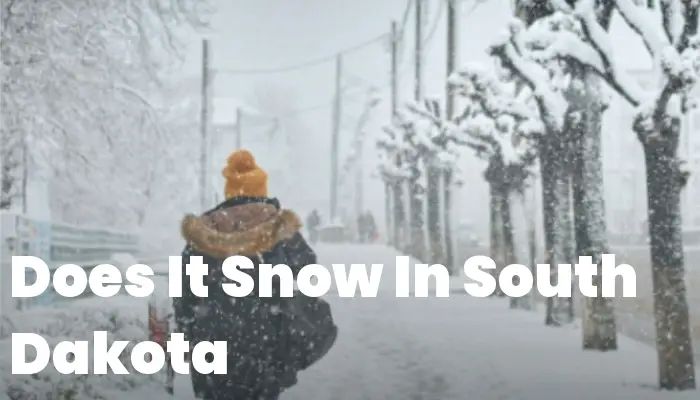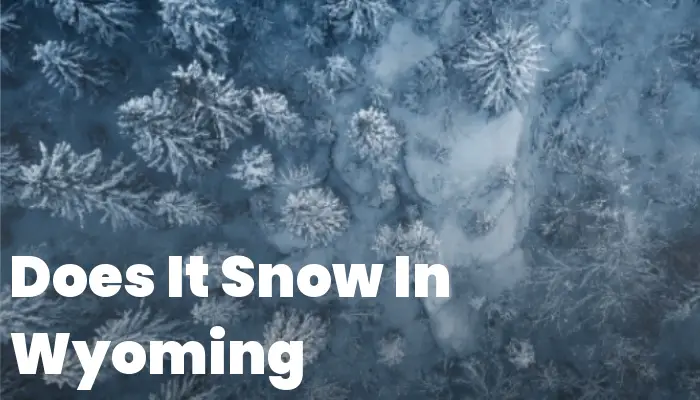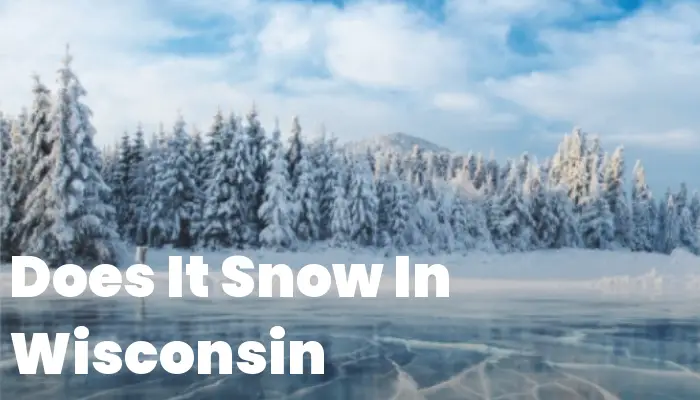Are you wondering about the climate in the “Mount Rushmore State”? Do you question, “Does It Snow In South Dakota?” Riveting and unpredictable, South Dakota’s weather could be just as fascinating as its rich history and culture. This article will delve into not only whether it snows but also when, how much, and how this impacts life in South Dakota. We’ll peel back each layer of this meteorological mystery to provide a comprehensive overview. Stay tuned…
Does It Snow In South Dakota?
If you’re one to enjoy a white winter, you’re in luck. The answer is a resounding “Yes”, it does snow in South Dakota. While the state has a largely continental climate, with hot summers and cold winters, snowfall is an integral part of its winter season.
South Dakota’s terrain is split between the eastern region and the western Black Hills, each bringing its own weather patterns. The eastern side of the state experiences more consistent snowfall due to being flatter and more exposed to Arctic blasts from Canada. In contrast, the Black Hills act as a barrier which can result in heavier but more localized snowfall.
Typically, snow begins to dust South Dakota around late October or November and can continue into April. However, this can vary; some areas may see their first flakes earlier or enjoy them later as spring approaches. Regardless of where you are in the state, winter brings about not only challenges for residents but also opportunities for various outdoor activities like skiing and snowmobiling.
Snow Coverage Across The State
Areas such as Aberdeen in northeastern South Dakota see an average of approximately 38 inches of snow annually while Sioux Falls accumulates about 44 inches on average. Rapid City has slightly less with closer to 41 inches annually due to some protection from the Black Hills.
How Much Does It Snow In South Dakota?
As for how much it actually snows across this vast state – that’s where things get interesting. Snowfall amounts vary significantly depending on both geographic location within the state and yearly meteorological variations.
In general terms, you can expect anywhere between 30 to 60 inches (76 – 152 cm) of annual snowfall if you’re residing or visiting anywhere in South Dakota. However, heavier amounts tend to be recorded in the northern parts of the Black Hills where communities such as Lead can accumulate over 100 inches (254 cm) because of higher elevation and favorable conditions for orographic lift which causes more precipitation.
Average Annual Snow by Region
Let’s break down some regional specifics:
- Pierre: Central South Dakota sees around 37 inches.
- Rapid City: Western area near Black Hills averages around 41 inches.
- Spearfish: Also near Black Hills but often gets slightly more than Rapid City.
- Sioux Falls: Southeastern region receives approximately 44 inches.
These numbers give us just a snapshot; local topographical features create microclimates that result in varied experiences even within these regions.
Are There Ice Storms In South Dakota?
Winter isn’t only about gentle flakes falling from gray skies—ice storms are another feature of South Dakotan winters that residents must contend with.
Ice storms occur when droplets of super-cooled water freeze upon contact with surfaces that are at freezing temperatures – typically roads, trees, power lines – creating slick layers of ice sometimes known as “glaze.” These types of storms can lead to treacherous driving conditions, widespread power outages due to downed lines and trees plus extensive damage property.
The Impact on Daily Life
During an ice storm warning period residents are often advised by local authorities to prepare emergency kits with food supplies electricity generation options should they experience lengthy power outages.
However despite its issues ice also transforms landscapes into stunningly beautiful scenes blanketed by sheaths sparkling crystals something many locals cherish during harsh winter months providing unique photography opportunities until thaw begins.
Notably major cities such Pierre Sioux Falls well-equipped handle extreme weather events including ice storms ensuring roads cleared quickly response units stand by assist those need although every resident encouraged stay updated weather advisories take necessary precautions during these icy times.
In conclusion while charming seasonal experience important aware potential dangers associated ice preparations considered seriously person living traveling through “Mount Rushmore State” during colder months year ensuring safety convenience retained throughout period.
Stay informed plan accordingly enjoy breathtaking snowy icy panoramas safely responsibly time comes embrace what Mother Nature offers — quintessentially diverse sometimes unforgiving climate heartland America known endearingly simply — wonderful snowy world South Dakota.
While researching the weather patterns of various US states, it’s fascinating to compare the question “Does It Snow In South Dakota?” to similar queries for other regions. South Dakota gets a significant amount of snowfall, but how does it stack up against other states? For instance, Does It Snow In Tennessee? Tennessee experiences snowfall as well, but typically less than South Dakota.
What about in more southern locations like Texas? When you ask Does It Snow In Texas, you’ll find that it does occur, albeit rarely and not as much as in South Dakota.
On the contrary, if one queries Does It Snow In Utah, we see that Utah shares a snowy climate with South Dakota due to its mountainous regions.
When compared to northern states like Vermont though, where the question is more likely “how much does it snow?“, the answer involves significantly heavy snowfalls which outpaces those typically seen in South Dakota.
Overall, while each state experiences varying degrees of winter weather, they all share a common thread – they each have their unique relationship with snowfall.
Where Does It Snow In South Dakota?
Snowfall in South Dakota is not uniform across the state and varies greatly depending on the region. The Black Hills, for instance, serve as a snow magnet due to their elevation and geography which induces orographic lift. This brings significant snowfall to towns such as Lead and Deadwood. As mentioned earlier, these areas can receive in excess of 100 inches of snow annually.
In contrast, the eastern part of South Dakota including cities like Sioux Falls, Brookings, and Watertown, also experiences ample snowfall but less when compared to the Black Hills region. These areas benefit from flatter terrain but are more exposed to arctic air masses that swoop down from Canada, bringing consistent winter storms and snowy conditions.
The central region, where you find the state capital Pierre, still receives a considerable amount of snow although slightly less intense than its eastern counterpart due to being sheltered by surrounding geographical features. However, this area is not immune to occasional blizzards that sweep across the state bringing heavy snowfalls in short periods.
Variability By Year And Storm Systems
Every year brings its own pattern of snowfall. Some winters are milder with modest amounts of snow while others are characterized by frequent storms that contribute to above-average totals. Furthermore, El Niño or La Niña weather patterns can have a significant influence on how much and where it snows in South Dakota.
South Dakota Roads and Winter Weather Conditions
Traveling through South Dakota during winter months requires preparation as road conditions can become challenging due to ice and snow accumulation. The state’s Department of Transportation works diligently with plowing operations but travelers should always exercise caution.
Main thoroughfares such as Interstate 90 (I-90), which traverses from east to west, or Interstate 29 (I-29), running along the eastern edge north-to-south, often receive prompt attention during storms. Nonetheless, even these major routes can be temporarily closed during severe blizzards.
Road Safety Measures And Advisories
The local authorities frequently issue travel advisories during winter weather events alerting drivers about hazardous conditions on roads. In addition to heeding these warnings, residents often outfit their vehicles with winter tires or chains for additional traction.
Lightweight trucks deploy sand or gravel over icy patches whereas heavier trucks lay down salt mixtures designed melt ice more efficiently before plows clear way ensure motorist safety service continues uninterrupted despite adverse weather.
Drivers should keep emergency kits in their vehicles including blankets food water flashlight any necessary medications case stranded also wise listen local radio stations check online resources like SafeTravelUSA updates regarding road closures delays caused by inclement weather.
How Cold Does It Get In South Dakota?
Winter temperatures in South Dakota can be bone-chillingly cold with mercury plummeting well below freezing mark especially overnight when skies clear winds calm allowing surface heat escape into atmosphere resulting bitterly cold mornings.
Average Temperature Ranges During Winter Months:
On average parts South most notably Black highest elevations experience lows reaching down minus 20 degrees Fahrenheit (-29 degrees Celsius) certain cold snaps have resulted even lower temperature readings statewide including all-time records far below zero.
Additionally wind chill factor becomes critical consideration when evaluating just how cold feels outside strong winds coupled already low thermometer readings lead extremely harsh feel-like temperatures times significantly increasing risk hypothermia other related health concerns individuals exposed elements without proper clothing protection warming facilities readily available.
Overall while certainly does boast beautiful snowy landscapes come wintertime evidence clearly suggests one must also respect potential hazards subzero temps bring particularly regards personal safety road travel preparedness key ensuring enjoyable safe season residents visitors alike.
When considering the climatic patterns of South Dakota, it is evident that snowfall is a characteristic feature of the state’s winter months. For instance, in Rapid City, snow adds a picturesque dimension to the landscape, typically from autumn through early spring. Similarly, Sioux Falls experiences a significant amount of snowfall that transforms the city into a winter wonderland, providing a seasonal charm and opportunities for winter sports. Moving northwards to Aberdeen, residents and visitors alike are greeted by the white blanket of snow that can be quite substantial during peak winter months.
Similarly, college town Brookings also receives its fair share of snow, affecting campus life and activities with snow-related events or closures. Last but not least, those in Watertown are well-acquainted with snowy conditions that are synonymous with South Dakota’s cold season. Overall, proving true to its northern location and continental climate, South Dakota offers an array of snowy environments across different cities within its borders.
Winter Activities In South Dakota
South Dakota transforms into a winter wonderland, offering a delightful array of activities for those who love the cold and snow. The state’s landscape becomes a playground for winter sports enthusiasts and families looking for fun during the colder months.
Skiing And Snowboarding
The Black Hills region, with its higher elevations and heavy snowfall, provides ideal conditions for skiing and snowboarding. Resorts such as Terry Peak and Mystic Miner at Deer Mountain offer slopes that cater to all levels of ability, from beginners to advanced skiers.
Snowmobiling
With over 1,500 miles of snowmobile trails, South Dakota is a paradise for snowmobilers. The vast trail system is well-maintained and takes riders through some of the most scenic parts of the state, including the Black Hills National Forest.
Ice Fishing And Skating
For those interested in quieter pursuits, ice fishing is a popular pastime on South Dakota’s frozen lakes. Likewise, many communities maintain outdoor rinks where families can enjoy ice skating.
Festivals And Events
Various winter festivals celebrate the season in South Dakota. Events like Deadwood’s Mardi Gras Weekend or Sioux Falls Winter Carnival offer unique experiences filled with colorful parades, ice sculptures competitions, and more.
Winter in South Dakota offers countless opportunities to create lasting memories amidst its frosty splendor—whether it be high-adrenaline sports or peaceful evenings on an iced-over lake waiting for fish to bite. Every activity is laced with the charm that only this snowy season can provide.
.
Winter Traveling In South Dakota
Traversing through South Dakota’s winter landscape requires preparation and caution. The state may be stunning under its white blanket but also presents challenges when it comes to transportation during snowy months.
Navigating Snow-Covered Roads Safely
Before setting out on your journey across wintry roads, ensure your vehicle is prepared. Adequate tires are essential—consider equipping your car with snow tires or chains. A packed emergency kit should also be part of your travel essentials; warm blankets have food water a flashlight first-aid supplies may become invaluable if you face delays mechanical issues due weather-related incidents traffic jams caused by storms blizzards.
The importance of staying informed cannot be overstated. Maintaining up-to-date knowledge about weather conditions route statuses helps travelers make smart decisions avoid hazardous areas altogether whenever possible.
Local resources such as SD511 SafeTravelUSA provide real-time information regarding road closures accidents areas affected by severe weather giving drivers an advantage navigating challenging conditions.
While exploring picturesque landscapes doused in powdery white remember safety should always come first allowing both residents visitors alike experience magic beauty that comes each year when Mother Nature drapes her snowy gown over rugged terrain inviting lands Mount Rushmore State.


